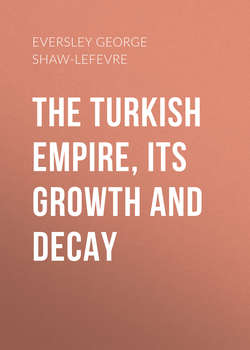The Turkish Empire, its Growth and Decay

Реклама. ООО «ЛитРес», ИНН: 7719571260.
Оглавление
Eversley George Shaw-Lefevre. The Turkish Empire, its Growth and Decay
PREFACE
PART I. THE GROWTH OF EMPIRE
I. OTHMAN. 1288-1326
II. ORCHAN. 1326-59
III. MURAD I. 1359-89
IV. BAYEZID I. 1389-1403
V. MAHOMET I. 1413-21
VI. MURAD II. 1421-51
VII. MAHOMET II, ‘THE CONQUEROR’ 1451-81
VIII. BAYEZID II. 1481-1512
IX. SELIM I. 1512-20
X. SOLYMAN THE MAGNIFICENT. 1520-66
XI. GRAND VIZIER SOKOLLI. 1566-78
PART II. THE DECAY OF EMPIRE
XII. THE RULE OF SULTANAS. 1578-1656
XIII. THE KIUPRILI VIZIERS. 1656-1702
XIV. TO THE TREATY OF PASSAROWITCH. 1702-18
XV. TO THE TREATY OF BELGRADE. 1718-39
XVI. TO THE TREATY OF KAINARDJI. 1739-74
XVII. TO THE TREATY OF JASSY. 1774-92
XVIII. TO THE TREATY OF BUCHAREST. 1792-1812
XIX. MAHMOUD II. 1808-39
XX. THE RULE OF ELCHIS. 1839-76
XXI. ABDUL HAMID II. 1876-1909
XXII. THE YOUNG TURKS. 1909-14
XXIII. A RETROSPECT
APPENDIX. GENEALOGY OF THE OTTOMAN SULTANS
Отрывок из книги
Towards the middle of the thirteenth century a small band or tribe of nomad Turks migrated from Khorassan, in Central Asia, into Asia Minor. They were part of a much larger body, variously estimated at from two to four thousand horsemen, who, with their families, had fled from their homes in Khorassan under Solyman Shah. They had been driven thence by an invading horde of Mongols from farther east. They hoped to find asylum in Asia Minor. They crossed into Armenia and spent some years in the neighbourhood of Erzerum, plundering the natives there. When the wave of Mongols had spent its force, they proposed to return to Khorassan. On reaching the Euphrates River Solyman, when trying, on horseback, to find a ford, was carried away by the current and drowned. This was reckoned as a bad omen by many of his followers. Two of his sons, with a majority of them, either returned to Central Asia or dispersed on the way there.
Two other sons, Ertoghrul and Dundar, with four hundred and twenty families, retraced their course, and after spending some time again near Erzerum, wandered westward into Asia Minor. They came into a country inhabited by a kindred race. Successive waves of Turks from the same district in Central Asia, in the course of the three previous centuries, had made their way into Asia Minor, and had taken forcible possession of the greater part of it. They formed there an Empire, known as that of the Seljukian Turks, with Konia, the ancient Iconium, as its capital. But this Empire, by the middle of the thirteenth century, was in a decadent condition. It was eventually broken up, in part, by assaults of a fresh swarm of invaders from Central Asia; and in part by internal civil strife, fomented by family disputes of succession.
.....
Timur reinstated in their former territories, as tributaries to his own Empire, most of the petty princes who had been dispossessed by the Turks, including the Emir of Karamania. He eventually returned to Samarkand, where he made preparations for the invasion of China, but before this could be realized he died, at the age of seventy-one, two years after the death of Bayezid. As a result of his raid into Asia Minor the Ottoman Empire there, for the time being, completely collapsed. But the Tartars disappeared without leaving any trace behind them.
If Bayezid’s physical downfall was overwhelming and humiliating, his moral decadence was even worse, and, as it turned out, was more permanently injurious to the people of his Empire by the evil example it set. In the brief periods of peace, spent at Brusa and Adrianople, he gave way to self-indulgence and vice of a deplorable kind. He was the first of his race to break the laws of the Prophet and to drink too freely of wine. In company with his Grand Vizier, Ali, he was addicted to drunken orgies. Still worse, he was tempted by that boon companion to give way to vice of unmentionable depravity, condemned by all the world. The Empire was ransacked for good-looking boys, the sons of Christian parents, who were compelled to embrace Islamism and to enter the service of the Court, nominally as pages, but really to pander to the degrading desire of the Sultan. In adopting such practices, Bayezid set the fashion to others of his entourage. The moral infection then spread widely among the upper classes of society, especially among the judges and ulemas. There can be little doubt that immorality infected the upper society of the Empire and was one of the causes which ultimately led to decadence and ruin.
.....